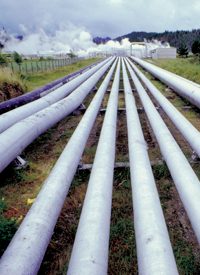
With funding from Google’s philanthropic division, Google.org, the Geothermal Laboratory at Southern Methodist University (SMU) recently completed a study on geothermal potential in the continental United States. The grant money enabled SMU to include “tens of thousands of new thermal data points” to construct the most accurate subterranean heat flow map to date. SMU scientists estimate U.S. potential at nearly three million megawatts of power, an amount more than adequate to supply current domestic electricity needs.
Unleashing geothermal energy requires drilling several miles beneath the Earth’s surface to unlock heat trapped in the crust. Well operators inject water in a continuous loop into fractures formed by the drilling process. As the water heats up, it is piped back to the surface where the steam drives an electricity-generating turbine. Google.com quotes Secretary of Energy Steven Chu extolling the virtues of geothermal as a reliable form of energy because “the earth is going to be hot. You can bank on it, [so] you can consider the energy source effectively in unlimited supply.”
Yet after millions in taxpayer funding for years of research and development, why does geothermal still account for less than one percent of U.S. energy production? Google.com let the answer slip in quoting Dr. Jefferson Tester, professor of chemical engineering at the Massachusetts Institute of Technology. “Once you get large and you do this large on a national basis,” asserted Tester, “the costs will come down naturally.”
A degree in chemical engineering obviously involves little economics training. Writing for The New American Ed Hiserodt helped explain why geothermal drilling costs in most areas are so prohibitive.
At most locations, to get sufficiently high temperatures to produce steam would require drilling to a depth of 30,000 feet — nearly six miles down! This is between the deepest land-based well ever drilled (24,000 feet in California) and the deepest well in the world (36,000 feet in Russia). Costs for drilling to these levels are not readily available, but drilling to 20,000 feet would cost an estimated $10 million, with costs rising rapidly at increasing depths. It wouldn’t be surprising for the cost to exceed $50 million per well to drill to a depth of 30,000 feet — provided someone could be found with the equipment and technology to take on such a project.
Aren’t these expenses worth saving Earth from noxious greenhouse gas emissions? In Google.com’s geothermal promo, Tester states electricity production from geothermal wells is “essentially emissions free and carbon neutral.”
But geothermal drilling has its own footprint, causing environmental groups to oppose it for decades. Tom Tanton, former general manager of the Electric Power Research Institute, listed some of the problems for Environment and Climate News. “Geothermal power plants tend to emit hydrogen sulfide (H2S) — which is toxic at fairly low levels — and mercury,” Tanton explained. “Whatever is not reinjected into the ground can cause local groundwater pollution. Geothermal fluids are always foul-smelling. They smell like very rotten eggs due to the H2S. The fluids are highly brackish and contain high levels of heavy metals.”
Another aspect that has people steamed is the tendency of geothermal drilling to trigger increased seismic activity. Seismologist David Oppenheimer of the U.S. Geological Survey Earthquake Hazards Team confirmed in Scientific American that there is danger associated with geothermal drilling. Speaking of The Geysers, the world’s largest complex of geothermal power plants located on 45 square miles north of San Francisco, Oppenheimer observed, “We’ve been monitoring [it] since 1975. All the earthquakes we see there are [human] induced. When they move production into a new area, earthquakes start there, and when they stop production, the earthquakes stop.”
Quake fears have pulled the plug on several drilling operations, including the AltaRock project at The Geysers launched in 2008 with a $6.2 milllion grant, courtesy of U.S. taxpayers. Unfortunately, the most viable geothermal wells are located in areas already prone to seismic activity.
Correction: This article as originally published concluded with a quote from Bloomberg by Ann Robertson-Tait, Senior Geologist and Business Development Manager for GeothermEx Inc., a geothermal resource consulting company. The quote mistakenly led readers to believe she said no geothermal operations can be considered commercially operable at present because of the seismicity issue.
Robertson-Tait was in fact referring specifically to Enhanced Geothermal Systems (EGS), which is a new geothermal drilling technology. She considers that particular technology not yet profitable because it is still in its infancy. Robertson-Tait contacted The New American to request a correction and explain her position, emphasizing that natural seismicity is not holding back geothermal development.
She explained by e-mail:
Even Bloomberg changed the meaning of what I said, although they were reasonably close. The quote I authorized (shortened/modified by Bloomberg) is:
“Although research and development efforts to lower the cost and increase the success of EGS are underway in the U.S. and many other countries, there are few places where EGS can be considered commercial at present,” Ann Robertson-Tait, business development manager at resource consultancy GeothermEx, Inc., said in an e-mail. In countries like Germany, where electricity prices are high, “there is a strong impetus by experienced developers to work through the technology limitations and implement EGS power,” she said.




